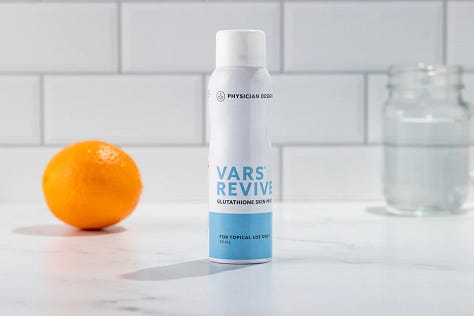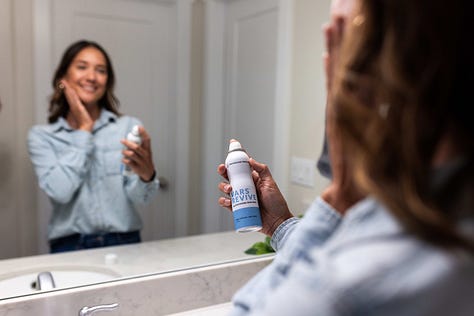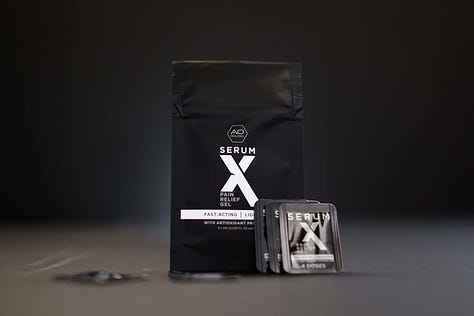A Novel Approach for Resolution of Chronic Shingles and Postherpetic Neuralgia (PHN) and Break-Outs in 5 Patients
A small participant study carried out in 2019-2020
The following study comes from data collected using early prototypes of a Glutathione product called Shingular. Although Shingular is no longer for sale, the upgraded version of it is now selling through PhysicianDesigned.com.
If you or a loved on is suffering or has suffered from Shingles and PHN, VARS Revive Topical Glutathione Skin Mist is here to save the day.
In conjunction with VARS Revive, Serum X Topical Pain Relief Gel is fantastic at fighting those lingering pains. The SOD in Serum X works in tandem with Glutathione, they are co-antioxidants within our cells. More info on that coming soon.



By Dan Purser MD; Jared Larkin
Abstract
Over a 5-week period (in 2017), 5 patients, with severe chronic shingles or Post-Herpetic Neuralgia (PHN), were treated with a novel substance of patented stable reduced glutathione (reduced form is called GSH versus the oxidized form which is called GSSG) in a natural liposomal carrier. Most of these patients (average age approximately 73 years) had failed to resolve their symptoms with antivirals, narcotics, and other treatments (mostly NSAIDs or tricyclic antidepressants). Most had pain self-ratings of 4-10 (average of a 7 on a scale of 1-10). The average length of break-out was 12 months (one as long as 2 years). Most had lost hope and were severely depressed. On first visit, all were treated with 3-4 sprays (directly on the site) with the topical reduced glutathione (patent 10,272,130) in a liposomal carrier. All (100%) reported complete resolution of the pain within less than 34 minutes. With repeated application (every 4-6 hours gradually decreasing to daily), the pain (PHN) did not return, all skin lesions healed within 72 hours with minimal scarring, nor did further breakouts occur.


Background
Chronic Shingles (along with PHN — Post-Herpetic Neuralgia) is a major public health problem and health concern. In one Italian study, PHN was still present after months of illness -- “370 of the 413 patients (89.6%) reported HZ-associated pain which was still present in 20.6% and 9.2% of patients after three and six months, respectively, despite many patients receiving recommended antiviral therapy.” Herpes Zoster occurs in more than 500,000 people in the United States each year, during the lifetimes of as much as 20%–30% of the population, and in as many as 50% of those living until at least 85 years of age. The British Medical Council journal reported that “up to 20% of patients with HZ (herpes zoster) develop PHN, which is moderate-to-severe chronic pain persisting for months or years after the acute phase.” In 2001 the Mayo Clinic noted that, “the annual medical care cost of treating incident HZ cases in the United States, extrapolated from the results of this study in Olmsted County, is estimated at $1.1 billion.” It is probably much higher today and is a huge cost burden on society. Also, PHN or post-herpetic neuralgia is the most common cause of suicide in patients with chronic pain over the age of 70 in the United States and Western Europe. This is despite treatments with antiviral medications, narcotics, and pain patches – there has been no way for many to resolve the pain and ends up being a common cause of heavy opioid use and addiction.
Topical glutathione has been shown to be beneficial against shingles and other viral infections and is the most antioxidant and antiviral substance we create in our bodies, but our production and levels decline as we age Genetic errors such as GSTM1, GSTT1 and other genetic errors/polymorphisms are now known in a certain percentage of the population to cause lack of creation of adequate amounts of reduced glutathione (GSH) or leading to an inadequate ability to reduce oxidized glutathione (GSSG) to reduced (active form) glutathione (GSH) thus increasing toxic elements and causing dysfunctional metallothioneins. Reduced glutathione is also critical to immune protection from these viruses such as varicella-zoster, EBV and HIV and other diseases -- this association cannot be overstated. Historically the problem with glutathione therapy and the marketplace has been how do physicians effectively give a stable, reduced form that was easily applicable and truly functional. A novel substance developed by myself and a partner in Provo, Utah which involves a stabilized, reduced, absorbable glutathione (GSH) that is sterile and can be sprayed on topically has led to unexpected results in quickly resolving acute and long standing shingles cases and PHN.
It’s also critical to note that we’ve now successfully treated over one hundred patients and volunteers with shingles, some who’d had the shingles and/or the PHN for as long as nine years and almost all had complete resolution of symptoms within 34 minutes (a handful, or less than 5%, took 2-5 days for complete resolution) which led to this slightly more formal study.
Methods and Findings
5 patients, with an average age of 77, with chronic shingles and severe post-herpetic neuralgia were treated over a five-week period. Some were on chronic doses of acyclovir, tricyclic antidepressants, and narcotics for pain but to no effect. Most at time of first visit admitted having significant depression and had considered suicide. Most patients also admitted to giving up hope (as previously noted, chronic shingles and PHN is the #1 cause of suicide in patients over age 70 in the USA and Western Europe). All were asked to self-rate their pain at the time of admittance to therapy and during this study – it averaged a 7 (which approximately matched the only major pain study to date regarding shingles pain) but many admitted that, when it was severe and a break-out was occurring, pain could spike to a 10.
Upon application of the complexed glutathione spray, the pain, in most participants, was noted to have completely resolved to zero (0) within an average of 34 minutes of application in all patients (most had complete resolution within one minute or less). The shingles tended to stay completely resolved thereafter with minimal pain recurrences (no new lesions). The few times the tingling or pain was reported to have recurred was when patients waited more than 6 hours to reapply the complexed glutathione on the first or second day. Reports indicated that there were no recurrences of any shingles outbreaks. Of interest, a few of these patients noted they also suffered from wet macular degeneration which itself may be due in part to a systemic glutathione deficiency.
Conclusions
This is a small study, but the findings are significant. There were also several factors holding back the utilization of glutathione as a treatment (instability of the reduced form or GSH, lack of efficacy of oxidized form or GSSG, lack of portability, lack of efficacy without using intravenous forms, etc.) which in turn are all mitigated by this new reduced form of topical glutathione (VARS® Liposomal Glutathione US PATENT # 10,272,130). This study needs to be performed on a larger scale.
Mechanism
The role of Glutathione (GSH) in immunology, especially as an antiviral, has been heavily studied, and new pathways and uses are being discovered every year. From current data and analysis, we have found that GSH is able to relieve the symptoms of and cure those who have chronic shingles as well as postherpetic neuralgia. GSH can help treat shingles by helping to remove reactive oxygen species (ROS) within virally infected cells as well as directly inhibiting the late end stages of the herpes virus life cycle, though these exact mechanisms are still unknown. Research has also shown that GSH is able to help coordinate and help activate different immune cells, such as macrophages, and help them to process antigens in a manner that allows them to activate CD4+ T cells. These CD4+ T cells then go on to activate CD8+ T killer cells to produce a Th1 response, which is the main response to fight viruses. If endogenous GSH is low in the body the macrophages will not function properly and end up leading to a CD8+ T cell response of Th2 cells which focuses primarily on bacteria. By having proper GSH levels, given exogenously since the virus depletes endogenous GSH, the immune system is able to work properly and provide the correct immunological response. On top of giving immune cells greater function, it has been shown that GSH is able to directly inhibit the late-stage replication of HSV-1 in vitro. This again shows that GSH has standalone antiviral activity that needs further study.
Postherpetic neuralgia is a common complication associated with shingles and is characterized by pain or a burning sensation left over from the area of where the shingles rash occurred. This pain can become so extreme that it is debilitating to the patient and can last weeks to years after the initial shingles infection has cleared out. This commonly leads to pain control with opioids and becoming a major cause of addiction. It is believed that PHN occurs because of the virus outbreak from nerves underneath the skin leading to lasting nerve damage. GSH has been shown to have many different neuroprotective benefits as well as helping repair damaged nerve cells. GSH is able to work in tandem to help clear and remove any virally infected cells as well as help repair damaged nerve cells during and after shingles and PHN.
References
1 Bricout H, Perinetti E, et al. Burden of herpes zoster-associated chronic pain in Italian patients aged 50 years and over (2009-2010): a GP-based prospective cohort study. BMC Infect Dis. 2014 Dec 6;14:637. doi: 10.1186/s12879-014-0637-6.
2 Palamara AT, Perno CF, et al. Evidence for antiviral activity of glutathione: in vitro inhibition of herpes simplex virus type 1 replication. Antiviral Res. 1995 Jun;27(3):237-53.
3 McCarty MF, DiNicolantonio JJ. An increased need for dietary cysteine in support of glutathione synthesis may underlie the increased risk for mortality associated with low protein intake in the elderly.
4 Gundacker C, Komarnicki G, et al. Glutathione-S-transferase polymorphism, metallothionein expression, and mercury levels among students in Austria. Sci Total Environ. 2007 Oct 15;385(1-3):37-47. Epub 2007 Aug 22.
5 Teskey G, Abrahem R, et al. Glutathione as a Marker for Human Disease. Adv Clin Chem. 2018;87:141-159. doi: 10.1016/bs.acc.2018.07.004. Epub 2018 Aug 23.
6 Fraternale A, Paoletti MF, Casabianca A, et al. Antiviral and immunomodulatory properties of new pro-glutathione (GSH) molecules. Curr Med Chem. 2006;13(15):1749-1755. Accessed Feb 10, 2020. doi: 10.2174/092986706777452542.
7 Juliana Echevarria Lima ED1 - Pinar Erkekoglu ED2 - Belma Kocer-Gumusel. The role of glutathione in viral diseases of the central nervous system. In: Glutathione in health and disease. Rijeka: IntechOpen; 2018:Ch. 5. https://doi.org/10.5772/intechopen.76579. 10.5772/intechopen.76579.
8 Palamara AT, Perno CF, Ciriolo MR, et al. Evidence for antiviral activity of glutathione: In vitro inhibition of herpes simplex virus type 1 replication. Antiviral Res. 1995;27(3):237-253. Accessed Feb 10, 2020. doi: 10.1016/0166-3542(95)00008-a.
9 Roxas, Mario. Herpes zoster and postherpetic neuralgia: Diagnosis and therapeutic considerations. Alternative Medicine Review. 2006;11(2):102-113. https://www.foundationalmedicinereview.com/wp-content/uploads/2019/02/v11-2-102.pdf.


